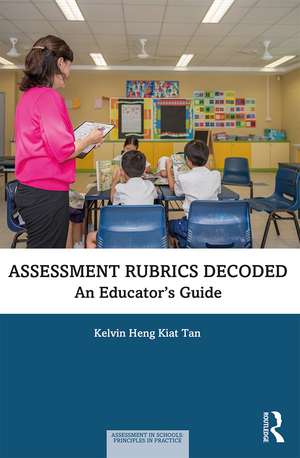Assessment Rubrics Decoded: An Educator's Guide: Assessment in Schools: Principles in Practice
Autor Kelvin Heng Kiat Tanen Limba Engleză Paperback – 15 apr 2020
This book will be a valuable resource for classroom teachers, school leaders, teacher educators and researchers interested in the field of assessment rubrics.
| Toate formatele și edițiile | Preț | Express |
|---|---|---|
| Paperback (1) | 285.29 lei 6-8 săpt. | |
| Taylor & Francis – 15 apr 2020 | 285.29 lei 6-8 săpt. | |
| Hardback (1) | 997.11 lei 6-8 săpt. | |
| Taylor & Francis – 15 apr 2020 | 997.11 lei 6-8 săpt. |
Preț: 285.29 lei
Nou
Puncte Express: 428
Preț estimativ în valută:
54.59€ • 56.100$ • 45.18£
54.59€ • 56.100$ • 45.18£
Carte tipărită la comandă
Livrare economică 04-18 aprilie
Preluare comenzi: 021 569.72.76
Specificații
ISBN-13: 9780367076832
ISBN-10: 0367076837
Pagini: 156
Ilustrații: 34 Tables, black and white; 27 Line drawings, black and white
Dimensiuni: 156 x 234 x 13 mm
Greutate: 0.12 kg
Ediția:1
Editura: Taylor & Francis
Colecția Routledge
Seria Assessment in Schools: Principles in Practice
Locul publicării:Oxford, United Kingdom
ISBN-10: 0367076837
Pagini: 156
Ilustrații: 34 Tables, black and white; 27 Line drawings, black and white
Dimensiuni: 156 x 234 x 13 mm
Greutate: 0.12 kg
Ediția:1
Editura: Taylor & Francis
Colecția Routledge
Seria Assessment in Schools: Principles in Practice
Locul publicării:Oxford, United Kingdom
Public țintă
Postgraduate and ProfessionalCuprins
Acknowledgements Chapter 1: Introduction to decoding rubrics Chapter 2: The challenges of understanding and using rubrics chapter 3: The Anatomy of a Rubric Chapter 4: Rubrics for Different Types of Learning and Learners Chapter 5: Rubrics for scoring, interpretations and decision-making by Lin Rongchan Chapter 6: How Rubrics are understood and used formatively Chapter 7: Rubrics, power, and conduct chapter 8: Effects of rubrics on students’ motivation and well-being by Alan Yang Qidong Chapter 9: Validating students’ voice in writing through self-assessment and rubrics creation by Salwati Salim and Jasmine Suppramaniam Chapter 10: Rubrics – a school leader’s perspective by Sheree Chong Index
Notă biografică
Kelvin Heng Kiat Tan is an associate professor in the Department of Learning Sciences and Assessment at the National Institute of Education, Nanyang Technological University, Singapore. He is one of the series editors for the Routledge book series Assessment in Schools: Principles in Practice.
Recenzii
‘This book presents a significant and thorough critical discussion of the widespread use of rubrics in educational assessment. The many advantages of rubrics as an assessment tool are accentuated, however, what impressed me more, was the profound critical reflection on the limitations and risks of using rubrics technically without the support of a comprehensive pedagogical perspective. This is a book parents, teachers, school leaders, and policy makers should be acquainted with.’ – Kari Smith, Professor, Head of Norwegian Graduate School in Teacher Education (NAFOL), Department of Teacher Education, NTNU, Norway
‘What you have in your hands is not the typical rubrics book. Kelvin Tan has done it again like he did in his 2012 “Student self-assessment: Assessment, learning and empowerment”. In this rubrics book he helps the reader to reflect about what are rubrics, their boundaries and how to take our understanding one step further’ - Ernesto Panadero, Researcher, Universidad Autónoma de Madrid, and Honorary Professor, Deakin University, Australia
'There is a general consensus in the field of education that rubrics work. This instructional tool is intended to articulate specific components and expectations for an assignment to students, enhance reliability of assessments, save instructors’ time when marking, and help students to improve their self-assessment capabilities. However, as with most tools in education, questions of how rubrics work, for whom, and under what instructional circumstances need to be explicated. This volume will help you to get answers to these – and many additional -- questions. It is written in a very engaging manner with plentiful practical examples and personal anecdotes, and will be a great resource for future and current educators. If you want to understand the nature, purpose, potential applications, advantages, and caveats of rubrics, this book is for you.' - Anastasiya A. Lipnevich, Associate Professor of Educational Psychology and Director of Faculty Research Development, Queens College and the Graduate Center,The City University of New York
‘What you have in your hands is not the typical rubrics book. Kelvin Tan has done it again like he did in his 2012 “Student self-assessment: Assessment, learning and empowerment”. In this rubrics book he helps the reader to reflect about what are rubrics, their boundaries and how to take our understanding one step further’ - Ernesto Panadero, Researcher, Universidad Autónoma de Madrid, and Honorary Professor, Deakin University, Australia
'There is a general consensus in the field of education that rubrics work. This instructional tool is intended to articulate specific components and expectations for an assignment to students, enhance reliability of assessments, save instructors’ time when marking, and help students to improve their self-assessment capabilities. However, as with most tools in education, questions of how rubrics work, for whom, and under what instructional circumstances need to be explicated. This volume will help you to get answers to these – and many additional -- questions. It is written in a very engaging manner with plentiful practical examples and personal anecdotes, and will be a great resource for future and current educators. If you want to understand the nature, purpose, potential applications, advantages, and caveats of rubrics, this book is for you.' - Anastasiya A. Lipnevich, Associate Professor of Educational Psychology and Director of Faculty Research Development, Queens College and the Graduate Center,The City University of New York
Descriere
Designed for both students and teachers, this book covers the problematic issues of assessment in schools at the same time as offering readers practical solutions for navigating the ensuing tensions and dilemmas.



